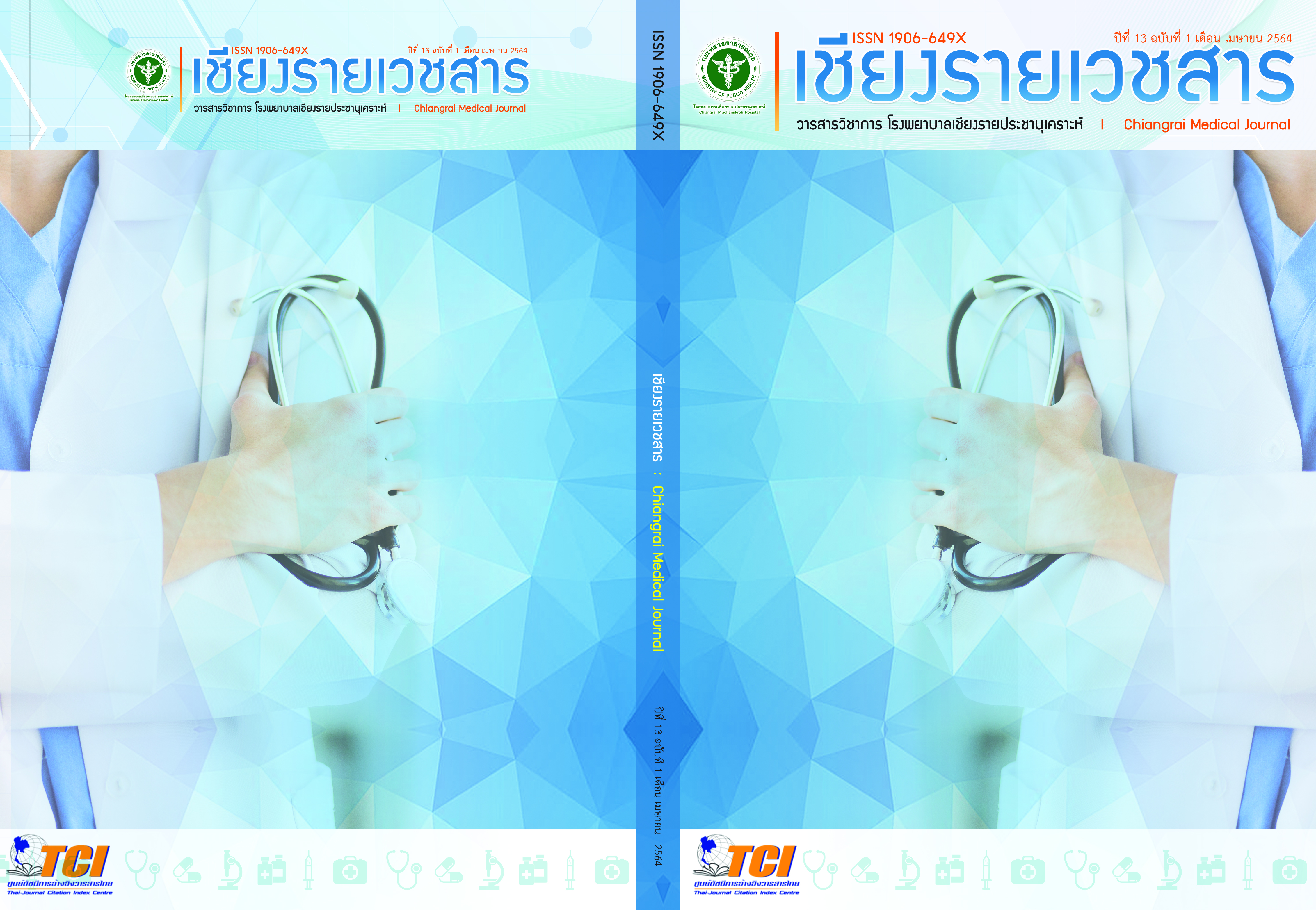ปัจจัยที่มีผลต่อการรอดชีวิตของผู้ป่วยหัวใจหยุดเต้นนอกโรงพยาบาลที่เข้ารับการรักษา ในโรงพยาบาลเชียงรายประชานุเคราะห์
Main Article Content
บทคัดย่อ
ความเป็นมา: ภาวะหัวใจหยุดเต้น (Cardiac arrest) เป็นภาวะฉุกเฉินทางการแพทย์ที่ต้องได้รับการรักษาอย่างเร่งด่วนโดยการช่วยฟื้นคืนชีพ โดยผู้ป่วยหัวใจหยุดเต้นนอกโรงพยาบาลมีอัตราการรอดชีวิตน้อย การศึกษาปัจจัยที่มีผลต่อการรอดชีวิตของผู้ป่วยหัวใจหยุดเต้นนอกโรงพยาบาลจึงมีความสำคัญที่จะพัฒนาระบบปฏิบัติการฉุกเฉิน
วัตถุประสงค์: เพื่อศึกษาปัจจัยที่มีผลต่อการรอดชีวิตและความสัมพันธ์ระหว่างคุณลักษณะของผู้ป่วยหัวใจหยุดเต้นนอกโรงพยาบาลกับปัจจัยที่มีผลต่อการรอดชีวิตของผู้ป่วยหัวใจหยุดเต้นนอกโรงพยาบาล
วิธีการศึกษา: : เป็นการศึกษารูปแบบ retrospective ในผู้ป่วยหัวใจหยุดเต้นนอกโรงพยาบาลอายุตั้งแต่ 18 ปี
ที่เข้ารับการรักษาในห้องฉุกเฉิน โรงพยาบาลเชียงรายประชานุเคราะห์ ตั้งแต่ 1 ตุลาคม พ.ศ. 2559– 30 กันยายน พ.ศ. 2561 โดยเก็บรวบรวมข้อมูลจากเวชระเบียนและวิเคราะห์ข้อมูลโดยใช้ t-test, exact probability test และ Logistic regression
ผลการศึกษา: ช่วงระยะเวลา 24 เดือนของการศึกษา พบว่าจำนวนผู้ป่วยที่เข้าเกณฑ์การศึกษา 133 ราย พบว่า ผู้ป่วยส่วนใหญ่เป็นเพศชาย (ร้อยละ 63.90) สาเหตุหลักของภาวะหัวใจหยุดเต้นนอกโรงพยาบาล ได้แก่ สาเหตุที่ไม่ใช่จากโรคหัวใจ ผู้ป่วยที่มี ROSC มากกว่าเท่ากับ 20 นาที จำนวน 49 ราย (ร้อยละ36.80) ปัจจัยที่มีผลต่อการรอดชีวิตของผู้ป่วยหัวใจหยุดเต้นนอกโรงพยาบาลอย่างมีนัยสำคัญทางสถิติ (P<0.05) ได้แก่ เวลาที่ใช้ในการออกเหตุ (response time) น้อยกว่า 8 นาที (OR 2.37, 95%CI1.07-5.27) และการกดนวดหัวใจเบื้องต้นโดยประชาชนที่พบเหตุการณ์ (OR 4.82, 95%CI1.68-13.87)
สรุปและข้อเสนอแนะ: ผู้ป่วยหัวใจหยุดเต้นนอกโรงพยาบาลมีอัตราการรอดชีวิตต่ำมาก ดังนั้นการพัฒนาศักยภาพของประชาชนให้มีความรู้ความเข้าใจเกี่ยวกับการช่วยฟื้นคืนชีพขั้นต้น รวมทั้งเพิ่มจำนวนเครื่อง AED ในจุดชุมชนหรือในสถานที่สาธารณะจึงเป็นเรื่องสำคัญและเป็นอีกหนึ่งทางเลือกที่จะทำให้เพิ่มอัตราการรอดชีวิตของผู้ป่วยหัวใจหยุดเต้นนอกโรงพยาบาลได้
Article Details
เอกสารอ้างอิง
Myat A, Song KJ, Rea T. Out-of-hospital cardiac arrest: current concepts. Lancet.2018:;391(10124):970-79.
Sasson C, Rogers MA, Dahl J, Kellermann AL. Predictors of survival from out-of-hospital cardiac arrest: a systematic review and meta-analysis. Circ Cardiovasc qual.2010;3(1):63-81.
Berdowski J, Berg RA, Tijssen JGP, Koster RW. Global incidences of out-of-hospital cardiac arrest and survival rates: systematic review of 67 prospective studies. Resuscitation.2010; 81(11):1479–87.
Atwood C, Eisenberg MS, Herlitz J, Rea TD. Incidence of EMS-treated out-of hospital cardiac arrest in Europe. Resuscitation.2005;67(1):75–80.
Hawkes C, Booth S, Ji C, Brace-McDonnell SJ, Whittington A, Mapstone J, et al. Epidemiology and outcomes from out-of-hospital cardiac arrests in England. Resuscitation.2017;110:133–40.
National Institute for Emergency Medicine. Situation report in Emergency Medical Services 2014. Bangkok: Phanyamit printing;2015.
National Institute for Emergency Medicine. Situation report in Emergency Medical Services 2015. Bangkok: Phanyamit printing:2016.
Cournoyer A, Notebaert É, Iseppon M, Cossette S, Londei-Leduc L, Lamarche Y, et al. Prehospital advanced cardiac life support for out-of-hospital cardiac arrest: a cohort study. Acad Emerg Med 2017;24(9):1100–9.
Kim TH, Kyungwon L, Sang DS, Young SR, Hideharu T, Yap S, et al. Association of the emergency medical services–related time interval with survival outcomes of out-of-hospital cardiac arrest cases in four Asian metropolitan cities using the scoop-and-run emergency medical services model. J Emerg Med 2017; 53(5):688-96.
Lai CY, Lin FH, Chu H, Ku CH, Tsai SH, Chung CH, et al. Survival factors of hospitalized out-of-hospital cardiac arrest patients in Taiwan: a retrospective study. PLOS ONE 2018;13(2):e0191954.
Martinez JP. Prognosis in Cardiac Arrest. Emerg Med Clin N AmEmerg. 2012;;30(1):91-103.
Ong ME, Shin SD, De Souza NN, Tanaka H, Nishiuchi T, Song KJ, et al. Outcomes for out-of-hospital cardiac arrests across 7 countries in Asia: the Pan Asian Resuscitation Outcomes Study (PAROS). Resuscitation.2015;96:100–8.
Perkins GD, Ji C, Deakin CD, Quinn T, Nolan JP, Scomparin C, et al. A randomized trial of epinephrine in out-of-hospital cardiac arrest a randomized trial of epinephrine in out-of-hospital cardiac arrest. N Engl J Med.2018;379(8):711-21.
Viereck S, Palsgaard Møller T, Kjær Ersbøll A, Folke F, Lippert F. Effect of bystander CPR initiation prior to the emergency call on ROSC and 30day survival-An evaluation of 548 emergency calls. Resuscitation. 2017;111:55-61.
Yates EJ, Schmidbauer S, Smyth AM, Ward M, Dorrian S, Siriwardena AN, et al. Out-of-hospital cardiac arrest termination of resuscitation with ongoing CPR: an observational study. Resuscitation.2018;130:21–7.
Ballesteros-Peña S, Abecia-Inchaurregui LC, Echevarría-Orella E. Factors associated with mortality in out-of-hospital cardiac arrests attended in basic life support units in the Basque Country (Spain). Rev Esp Cardiol (Engl Ed). 2013; 66(4): 269-74.
Amnuaypattanapon K, Udomsubpayakul U. Evaluation of related factors and the outcome in cardiac arrest resuscitation at Thammasat Emergency Department. J Med Assoc Thai. 2010 Suppl 7:S26-34.
Limsuriyakarn W. Factors associated with the outcome of out-of-hospital cardiac arrest at Emergency Department Phra Nakhon Si Ayutthaya Hospital. J Prev Med Assoc Thai.2018;8(1):15-23.


